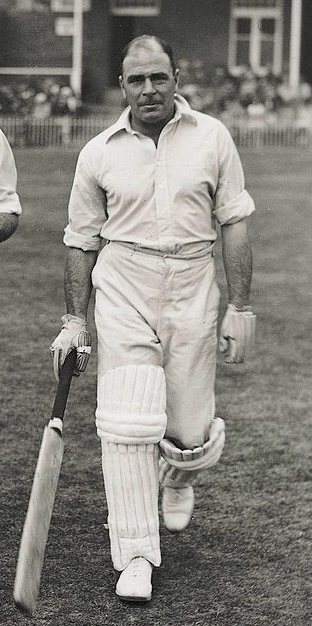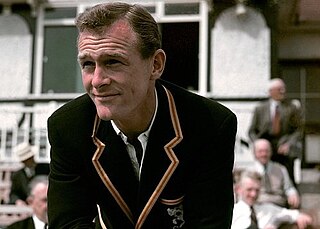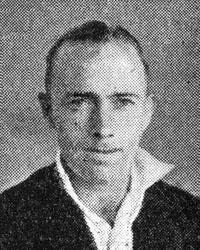Timothy Stephen Curtis is a former England cricketer, English teacher and Director of Sport at RGS Worcester. He retired from teaching in 2016.

Thomas William Graveney was an English first-class cricketer, representing his country in 79 Test matches and scoring over 4,800 runs. In a career lasting from 1948 to 1972, he became the 15th player to score one hundred first-class centuries; he was the first batsman beginning his career after the Second World War to reach this milestone. He played for Gloucestershire and Worcestershire, and helped Worcestershire win the county championship for the first time in their history. His achievements for England after being recalled in 1966 have been described as "the stuff of legend." Graveney was a Wisden Cricketer of the Year in 1953, captained England on one occasion and was awarded the OBE while still playing.
Neal Victor Radford is an English former first-class cricketer, who appeared in three Tests and six ODIs for England.

Richard Keith Illingworth is an English former cricketer, who is currently an umpire. The bulk of his domestic cricketing career was with Worcestershire, although he had a spell with Derbyshire, and overseas with Natal. He played in nine Tests and twenty-five ODIs for England, including participating in the 1992 and 1996 Cricket World Cups. He was a part of the English squad which finished as runners-up at the 1992 Cricket World Cup.
Graham Roy Dilley was an English international cricketer, whose main role was as a fast bowler. He played first-class cricket for Kent County Cricket Club and Worcestershire County Cricket Clubs, and appeared in 41 Test matches and 36 One Day International (ODIs) for the England cricket team.
Charles Henry Palmer was an English cricketer, who played for Leicestershire and Worcestershire from 1938 to 1959. He was born at Old Hill in Staffordshire. Palmer also played one Test match for England. He later went on to become a respected cricket administrator. He was awarded his CBE in 1984 for services to cricket in the Queen's Birthday Honours.

Vallance William Crisp Jupp was an amateur cricketer who played for Sussex and Northamptonshire. Jupp also played eight Test matches for England, and was named as one of the five Wisden Cricketers of the Year in 1928.

Peter Edward Richardson was an English cricketer, who played for Worcestershire and Kent County Cricket Clubs and in 34 Test matches for the England cricket team.

Cecil "Sam" Cook was an English first-class cricketer who played for Gloucestershire County Cricket Club and in one Test match for the England cricket team.
James Langridge was an English cricketer who played for Sussex and England. He played in eight Test matches between 1933 and 1946.
George Henry Pope was an English cricketer, who played for Derbyshire from 1933 to 1948, and in one Test for England in 1947.

Richard Howorth was an English cricketer who played as an all-rounder for Worcestershire County Cricket Club between 1933 and 1951. Chiefly remembered as a left-arm orthodox spin bowler, Howorth also occasionally bowled medium pace and was a capable hard-hitting left-handed batsman. Ideally he would bat in the middle of the order, but so weak was Worcestershire's batting for much of his career that Howorth would often play as an aggressive opener, and it was in this role that he hit his two highest first-class scores – curiously both being 114. Howorth was also a dependable close-to-the-wicket fielder but would field with skill further out if needed.
Roly Jenkins was an English cricketer from the period immediately after World War II, almost exclusively for Worcestershire County Cricket Club as a leg spinner. Along with Doug Wright and Eric Hollies, Jenkins was a star of the last generation of English leg-spinners before a more defensive mindset, followed by failed rule changes like a standard 75 yards (68.6 m) boundary and then the advent of one-day cricket, all but killed off home grown wrist spinners.
Robert Berry was an English cricketer. He played in two Test matches in 1950. He played county cricket for Lancashire from 1948 to 1954, for Worcestershire from 1955 to 1958, and for Derbyshire from 1959 to 1962. He was the first cricketer to be capped by three different counties.
Frank Anderson Lowson was an English cricketer, who played in seven Tests for England from 1951 to 1955. In first-class cricket, Lowson amassed 15,321 runs at an average of over 37, but had drifted away from the county game by his early thirties.

Leonard John Coldwell was an English cricketer, who played in seven Tests for England from 1962 to 1964. Coldwell was a right-arm fast-medium bowler who was, for a few years in the early to mid-1960s, half of a respected and feared new-ball partnership in English county cricket. With his bowling partner Jack Flavell, Coldwell was the attacking force behind the unprecedented success of Worcestershire which brought the county its first successes in the County Championship in 1964 and 1965.
John Henry Childs is a former cricketer who played in two Test matches for England in 1988. At the age of 36 years 320 days, Childs became the oldest player since Dick Howorth in 1947 to make his England debut. He was a left-arm spin bowler, and played his domestic cricket for Gloucestershire and Essex.
1947 was the 48th season of County Championship cricket in England. It is chiefly remembered for the batting performances of Denis Compton and Bill Edrich who established seasonal records that, with the subsequent reduction in the number of first-class matches, will probably never be broken. Their form was key to their team Middlesex winning the County Championship for the first time since 1921, although they were involved in a tight contest for the title with the eventual runners-up Gloucestershire, for whom Tom Goddard was the most outstanding bowler of the season. Compton and Edrich were assisted by the fact that it was the driest and sunniest English summer for a generation, ensuring plenty of good batting wickets.
Roy Booth was an English first-class cricketer, who played for both Yorkshire and Worcestershire. He was born at Marsden, West Riding of Yorkshire.
Peter Bernard Wight was a Guyanese first-class cricketer who played for Somerset, Canterbury and British Guiana. Wight was a prolific run scorer at the top of the order, scoring 16,965 runs during his thirteen years at Somerset; and at the time of his death only Harold Gimblett had made more runs for the county. After playing, he became an umpire in English first-class cricket, standing in matches from 1966 to 1995.






